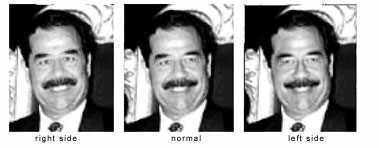
As you view these pictures, remember that the images on your far left represent the left brain, which, as described earlier, is usually the dominant side.
President George W. Bush
Saddham Hussein circa 1992
Young (14 yrs old) Saddham Hueesin
Guru Ramdas
--MORE-- Writing this article has demanded the cooperative efforts of both left and right brains of Dan Eden. Although I am left-handed, I discovered that this has little bearing on my left or right side domination. A vast majority of us "sinister" people have the same left brain domination as the right handers. Creativity and hand preference is another myth. Nevertheless, my right brain has had to work with its counterpart, feeding ideas and images that the left brain will methodically translate into correct verbiage and grammar. And your two brains are right now performing the same operations in reverse order. Evolution has already experimented with larger brains (the Neanderthals) and found that the increased demands for nutrition and temperature control were not worthy of the effort. Increasing our mental abilities now appears to rest in a method of coordinating the two sides, so that logic and intuition, reason and imagination, and science and philosophy can both play a part in the future of our species. Is Your Left Hand More Motivated Than Your Right Hand? According to reports in ScienceDaily, motivation doesn't have to be conscious; your brain can decide how much it wants something without input from your conscious mind. Now a new study shows that both halves of your brain don't even have to agree. Motivation can happen in one side of the brain at a time. Psychologists used to think that motivation was a conscious process. You know you want something, so you try to get it. But a few years ago, Mathias Pessiglione, of the Brain & Spine Institute in Paris, and his colleagues showed that motivation could be subconscious; when people saw subliminal pictures of a reward, even if they didn't know what they'd seen, they would try harder for a bigger reward. In the earlier study, volunteers were shown pictures of either a one-euro coin or a one-cent coin for a tiny fraction of a second. Then they were told to squeeze a pressure-sensing handgrip; the harder they squeezed it, the more of the coin they would get. The image was subliminal, so volunteers didn't know how big a coin they were squeezing for, but they would still squeeze harder for one euro than one cent. That result showed that motivation didn't have to be conscious.
For the new study, in Psychological Science, a journal of the Association for Psychological Science, Pessiglione and his colleagues Liane Schmidt, Stefano Palminteri, and Gilles Lafargue wanted to know if they could dig even farther down and show that one side of the brain could be motivated at a time. The test started with having the subject focus on a cross in the middle of the computer screen. Then the motivational coin -- one euro or one cent -- was shown on one side of the visual field. People were only subliminally motivated when the coin appeared on the same side of the visual field as the squeezing hand. For example, if the coin was on the right and they were squeezing with the right hand, they would squeeze harder for a euro than for a cent. But if the subliminal coin appeared on the left and they were squeezing on the right, they wouldn't squeeze any harder for a euro. The research shows that it's possible for only one side of the brain, and thus one side of the body, to be motivated at a time, says Pessiglione. "It changes the conception we have about motivation. It's a weird idea, that your left hand, for instance, could be more motivated than your right hand." He says this basic research helps scientists understand how the two sides of the brain get along to drive our behavior.
|






